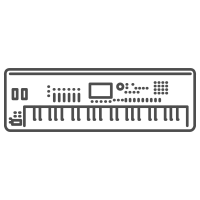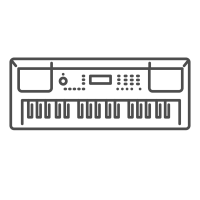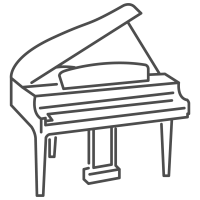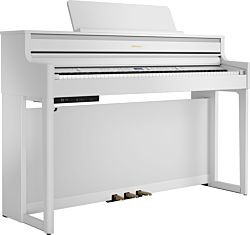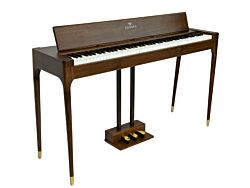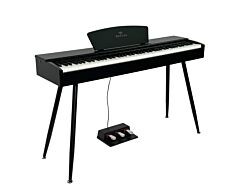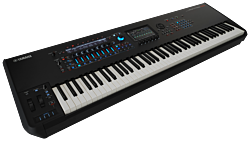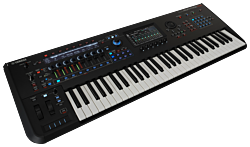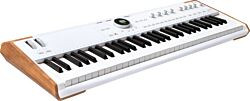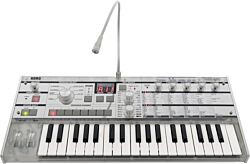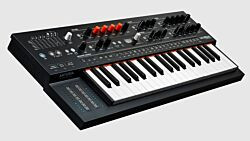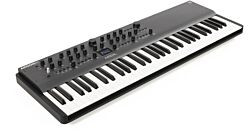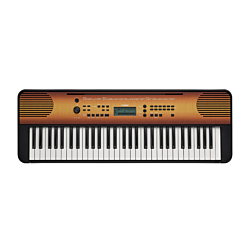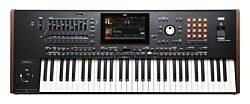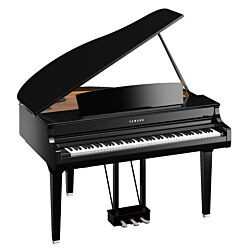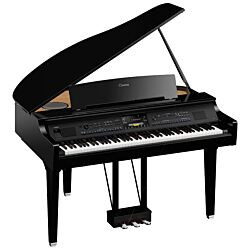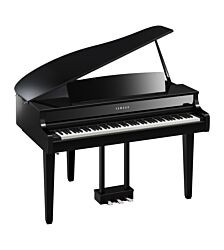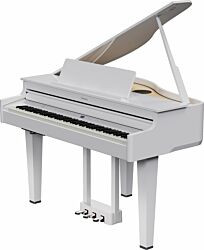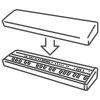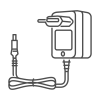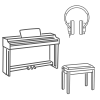In the 1970s, the world was introduced to a plethora of sounds and instruments in the form of the synthesizer. Since then, the development of both digital and analog synthesizers has gone hand in hand. However, the principles behind these two are slightly different; The analog synthesizer works by sending electrical signals through a series of modules and circuits, which are then manipulated so that the well-known synthesizer sound is generated. The digital synthesizer is basically a computer with keys. If you go one step further, this computer uses digital signal processing (DSP, digital signal processing), where, as indicated, you process an audio signal in relation to, for example, time and frequency.
If you want to read more about the origin of the synthesizer and its development over time, read this short article. The article may also provide a more thorough explanation of some of the concepts explained in this guide.

In the synthesizer world, there are several names for various effects and filters. Our goal here is to create an overview of these in this 'Synthesizer's ABC', where the most important concepts are explained in a clear way.
Amplifier
A circuit that increases the outgoing signal strength (gain) and is used to boost certain frequency ranges. It can be used to override the sound and produce an overdrive / distortion sound.
Arpeggiator
A tool that repeats the tones struck on the synthesizer's keys in a given pattern - up, down, up/down or random. The number of octaves over which the arpeggio is generated and the note value (duration) can be adjusted.
Attack
The first stage of a traditional Envelope filter (ADSR, Attack/Decay/Sustain/Release). When the envelope filter controls the amplifier, attack determines the time it takes the tone of the note to reach maximum volume (100%). For example, a piano reaches its maximum volume as soon as the hammer hits the strings, whereas a gong can slowly rise to the maximum volume.

Chorus
An effect that reproduces copies of a signal, which are reproduced tonally and temporally slightly out of sync from the original. The effect simulates a choir, in which not everyone can sing at the exact same tempo and tone - hence the name.
Compressor
A dynamic effect where you treat the dynamics so that they become uniform. This means that you set a threshold (a decibel level to be passed before an effect is activated), and when the volume exceeds this threshold, the Compressor effect is activated and the volume is lowered - ie you compress the sound to a suitable size. This effect can be used to give the sound a fuller expression.
Cutoff
Determines the frequency at which a filter starts operating.
D-Beam
Many Roland synthesizers feature a D-Beam. It is a sensor that can be manipulated or used to activate sounds, by moving one's hand over the sensor.

Decay
The second stage of the ADSR envelope. Decay describes how the sound fades right after the tone has reached its maximum volume.
Delay
An effect that reproduces an exact copy of a played sound. Delay can be set in many different ways; the amount of time until the repetition, how many times the tone needs to be repeated, the volume of the repeated tones, etc.
You can, for example, use delay to make a melodic theme richer, or use it to make even a simple melody sound much more complex.
Distortion
An effect that originally occurred by overriding an amplifier by sending too much voltage through it. Distortion is often heard in rock music, where the signal from a guitar to an amplifier is overriden, and you get the familiar sound of a rock guitar with distortion/overdrive.
Effects
A tool for modifying sound. There are three categories; Distortion, modulator (flange, chorus) and dimensional effects (Reverb, Delay).
Envelope
Describes the development of a sound over time. Envelopes must be activated by, for example, a key. ADSR envelopes are activated in this way, thereby determining how the activated tone should develop from start to finish, by controlling an amplifier.
EQ (Equalisation)
A tool for regulating the sound level in certain frequency ranges - typically bass, mid, treble. Normally you do not see EQ settings on synthesizers because you control the frequencies with various filters, but on stage pianos it is very normal.

Fine Tune
Pitch adjustment in very small intervals - typically in hundreds of a semitone, which is also called 'cents'.
Flanger
An effect that produces a 'swirling' sound by making a copy of the signal slightly offset from the original
Gain
Another term for sound level.
Glide
An effect that causes a tone to slide up / down on that tone.
High Pass Filter
By setting the cutoff, you can set a limit for which frequencies should pass the high pass filter. In this way, you only get frequencies above the set limit, where the frequencies below the limit are not included. The high pass filter is shown below, where the x-axis is frequency and the y-axis is decibel level.

Layer
When you place several sounds on top of each other.
Low Frequency Oscillator (LFO)
An oscillator that moves slowly and therefore generates low frequencies (around 20 Hz). One can use an LFO to create a pulse sensation in the music, and thus amplify the rhythmic layer in the music.
Low Pass Filter
Works in the same way as the High Pass Filter, but just the opposite. You set a given frequency limit with Cutoff, where frequencies lower than the limit pass and those higher than the limit are removed. This is visualized below, where the x-axis is frequency and the y-axis is decibel level.

MIDI
Acronym for "Musical Instrument Digital Interface". It is a system that allows digital instruments to communicate with each other.
Modulation (Mod)
A method of giving expression and movement to a sound. For example, you can use modulation to change pitch, filter and gain.
Modulation Wheel
A wheel to control a modulation effect (vibrato, tremolo)
Oscillator
The oscillator is the building block of a synthesizer. It is the component that generates a signal with a frequency. A synthesizer may have one or more oscillators, each of which may have a different waveform such as square wave, sine wave or saw wave.
Panning
Right / left positioning of a signal. By adjusting panning, you can send one signal all the way to the right, while another is all the way to the left.
Pitch-Bend
A tool to 'bend' a played tone - that is, make the tone higher or lower after you have played the tone.

Preset
A pre-programmed sound setting. Typically, one can store a number of presets in the synthesizer, and in that way quickly go back and forth between sounds, without having to change a lot of settings.
Release
The fourth stage of the aforementioned ADSR Envelope. Release describes how a sound develops after releasing the key. With release, you set the time it takes for the tone to fade completely (0% volume) once you release the key.
Sample
A digitally recorded sound that can be played via a synthesizer. For example, in Kawai and Yamaha's stage piano you will find samples from their own acoustic pianos.
Sawtooth wave
This waveform is characterized by the fact that it gradually rises, and immediately falls straight down again - or vice versa.
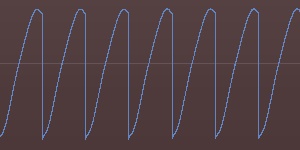
Sequencer
A tool for creating and recording several different layers of sounds directly in the synthesizer, which is very characteristic of Workstation Synthesizers.
Sine Wave
The purest form of sound waves - in the sense that it makes the purest sound. The wave takes the form of a sine curve:
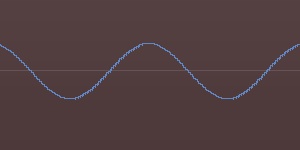
Split
A function that divides the piano into two or more parts, where you can play several separate sounds on your synthesizer at once.
Square Wave
As the name suggests, this waveform has a very angular shape, in that it goes abruptly straight up and down.
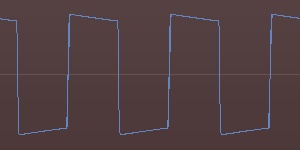
Sustain
The third stage of ADSR envelope. The sustain level determines the decibel level at which a note is sustained when the decay stage has ended.

Threshold
Used to determine which decibel level is to be passed before a dynamic effect is activated (eg compressor)
Timbre
Describes the aesthetic character of a sound and the quality of the sound. For example, a transverse flute has a soft and hollow timbre.
Tremolo
A modulation effect that affects the volume of a tone - the effect causes the volume to swing up and down at a certain speed.
Triangel Wave
A waveform that has a linear rise and fall.
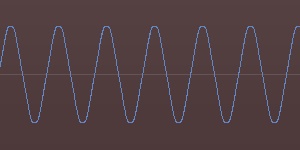
VCA
Voltage Controlled Amplifier - a circuit that controls volume.
VCF
Voltage Controlled Filter - a circuit that controls the filter cutoff.
VCO
Voltage Controlled Oscillator - a circuit that controls the pitch of the oscillator. By increasing the voltage in the circuit, waveforms are formed.
Vibrato
A modulation effect that can control the pitch of a tone. Vibrato makes the tone swing a little up and down, which can lead to a more nuanced expression.


